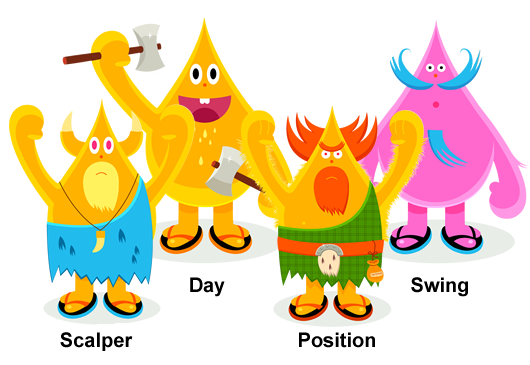How many types of forex traders are there? Some like to scalp the markets, while others play the long game of swing and position trading. Either way, every trader should know who they are as investors and which trading style aligns with their personality, risk appetite, skill level, and objectives.

They say there are many ways to achieve your goal, and in forex, this is especially true. Any traded financial market reflects the unique differences, personalities, and goals of millions of participants.
How an individual trader sees themselves in this vast ocean is one of the cornerstones of consistently profitable trading. This article will cover each of the six most common types of traders, what defines them, and what their ultimate objectives are.
The importance of knowing your trader type
We could imagine the forex market in a similar vein to the Mortal Kombat video game. Several fighting styles fit with the unique attributes of every fighter. While some are pretty quick and agile, relying on heavy kicks and grappling, others favor fewer but more powerful and lethal moves.
In the end, the objective remains the same, to defeat the opponent. In forex, we can use the same analogy. The market is dynamic in reflecting many varying philosophies of traders who all have the single goal of making a profit.
How they get to that milestone depends entirely on their trader type. The importance of understanding yourself and what type of trader you are cannot be understated. Each style aligns with specific personality traits, the trader’s resources, skills, and goals.
The 6 main forex trader types
The common knowledge is there are four trader types as in the image below:

These categories may have been valid when the forex market wasn’t as prevalent. However, with the growth of automated trading and even more short-term trading strategies, one could broadly conclude six types instead.
Scalpers
The first and most natural place to start is with scalping. Scalping is the practice of high-frequency trading characterized by a trader opening and closing multiple trades within a few minutes to even seconds.
Naturally, scalpers operate on smaller time-frames, namely the 1 minute, 5 minute, and, on some occasions, the 15 minutes. The objective of a scalper is collecting small profits repeatedly throughout a highly liquid trading session and currency, which accumulate to greater amounts over time.
Scalpers strongly dislike holding positions for any longer than a few minutes due to fearing price volatility and the dynamic nature of the markets. Most trading communities generally frown upon scalping due to the perception they are impatient, high-risk takers who thrive on fast-paced action.
In a technical sense, we could regard scalping as the riskiest and most stressful way to trade since making it a worthwhile endeavor necessitates large risks. If we combine this realization with the tendency for scalpers to use tight stops, it’s evident to see enormous losses can occur in a brief period if not treated carefully.
Day traders
Day trading may be a slightly less stressful version of scalping, with a few notable exceptions. As the name suggests, day trading is a popular strategy involving positions being opened and closed within the same trading day and not held overnight.
Day traders technically open far fewer positions than their scalping counterparts, though the frequency of these can still be a little higher than other traders. Day trading may be the sweet spot between scalping and swing trading as there is a fair amount of patience needed for this approach while avoiding the risk of holding positions for long.
However, like scalping, day traders need to spend considerable time watching charts. Day traders spend much of their time analyzing the 15-minute, 30-minute, and 1-hour time-frames.
Swing traders
Swing trading enters the realm of a long-term trading style. Traders employing this approach look to take advantage of price ‘swings’ for at least a few days up to a few weeks. Naturally, swing traders take far fewer positions than day traders and scalpers and will typically analyze higher time-frames starting from the 4-hour and above.
These time-frames don’t require constant screen time, making swing trading suitable for those with jobs or generally busier lifestyles. One needs far more patience for swing than day trading due to the hold time of positions.
Position traders
We can consider position trading in forex as Warren Buffett-like. This approach is an extreme form of swing trading, where traders hold positions for at least several months and even years. The trading frequency is the slimmest compared to the others (only a few trades a year).
Position trading embodies much of the spirit of The Oracle of Omaha himself through very long-term holding by examining deep fundamentals. While ‘technicals’ offer little significance, position traders need to observe higher time-frames, namely the daily, weekly, and monthly.
Employing this technique requires not only tremendous patience but also mental resilience, years of experience, and a large trading account to make it worthwhile.
News traders
News trading is a trading style driven by scalping during high-impact economic releases like the NFP (Non-Farm Payroll), GDP (Gross Domestic Product), and interest rate decisions. This method is favored by scalpers (and many day traders) who employ a different strategy to ‘trade the news’ based on its highly erratic nature for spikes and fast movements.
News trading requires quick reaction to data results on small time-frames (usually the 15 minute and below), low tolerance to risk, and knowledge of fundamentals. Such is the popularity of news trading over the years that some traders will only use this method to profit from the markets.
Algorithmic traders
Algorithmic trading refers to any trading reliant on some form of automation, most commonly high-frequency trading technology and expert advisors or robots. Proponents of this system believe computers make better trading decisions in an emotionless manner, unlike humans.
Algorithms and expert advisors all follow pre-coded instructions to the tee with practically no deviation or human discretion. Building such systems requires a trader to possess or outsource sufficient programming knowledge on a specific trading platform.
Conclusion
One of the first considerations for new traders is finding out what type of trader they are. When building a trading strategy, this factor is the difference-maker. We should also consider the trading style that has to align with personality, amount of risk capital, goals, and skill level.
More experienced traders may eventually find themselves switching to another style, which frequently happens to most and is a natural progression.








Leave a Reply